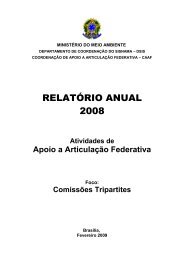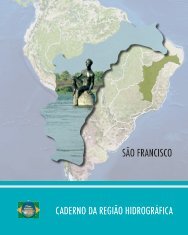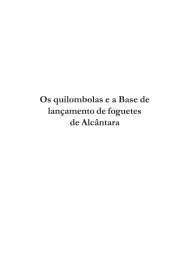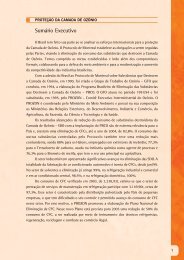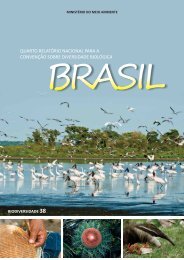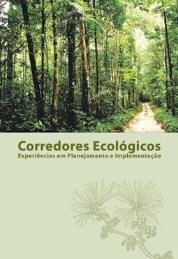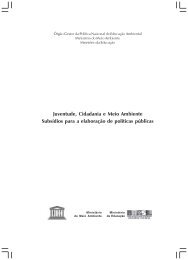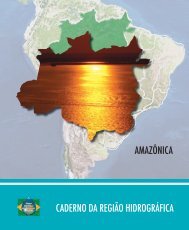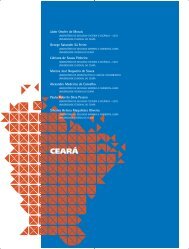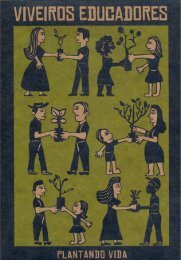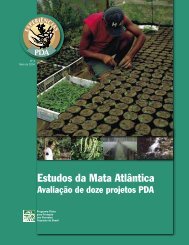developing the legal framework for itsconservation, increasing the area underprotection within the biome, improvingthe implementation of these areas andmonitoring deforestation within theCaatinga. Its specific objectives include:a) Updating the mapping of survivingareas and monitoring the vegetationcoverage of the biome;b) Monitoring and supporting the workof the National Council for the CaatingaBiosphere Reserve;c) Integrating actions of existing projectsfor the conservation and sustainable useof biodiversity in the Caatinga;d) Monitoring the policies, programmesand projects being carried out by theMinistry of the Environment and othergovernmental activities at the municipal,state and federal levels, in particularthose relating to the Conventions onBiological Diversity, DesertificationCombat and Climate Change, and therebyconstituting a key forum for dialogue withcivil society;e) Effectively establishing the CaatingaWorkin Group.The mandate the Caatinga WorkingGroup is to propose public policies forthe conservation and sustainable useof the Caatinga and programmes tothis end. The working group comprisesmore than fifteen institutions, includingrepresentatives of federal and stategovernments, non-governmentalorganizations and representatives ofthe scientific, agricultural and industrialsectors.The Cerrado BiomeThe Cerrado is the second largestbiome of South America and occupies2,036,448 Km² of land (22% ofthe entire Brazilian territory). Itscontinuous area extends into the statesof Goiás, Tocantins, Mato Grosso, MatoGrosso do Sul, Minas Gerais, Bahia,Maranhão, Piauí, Rondônia, Paraná,São Paulo and the Federal District, inaddition to insertions in the states ofAmapá, Roriama and Amazonas. Theheadsprings of South America’s threelargest hydrographic basins (Amazonas/Tocantins, São Francisco and Plata) arealocated in this territory, and thus yieldselevated water potential and favors itsbiodiversity.The Cerrado is considered to beone of the worldwide hotspots forbiodiversity and presents a significantabundance of endemic species andsuffers exceptional losses of habitat.From the point of view of biologicaldiversity, the Brazilian Cerrado is knownas the world’s richest savannahs. It ishome to over 6,500 species of alreadycataloguedplants, 44% of which are ofendemic flora. There is a wide array ofhabitats, which determine a noteworthyalternance of species among differentphytophysiognomies. Close to 199mammal species are known and therich avifauna includes approximately837 species. The number of fish (1200species), reptiles (180 species) andamphibians (150 species) is quiteelevated. The number of endemic fish isnot known, but the numbers are very highfor amphibians and reptiles – 28% and17%, respectively. According to recentestimates, the Cerrado is refuge to 13%of all of the tropic’s butterflies, to 35% ofall bees, and to 23% of all termites.In addition to the environmental aspects,the Cerrado has great social importance.Many traditional populations live off itsnatural resources, including indigenousethnic groups, quilombas, geraizeiros,27
iver-side populations, babaçueiros,vazanteiros and quilombola communitiesthat together are part of the historic andcultural heritage of Brazil and hold thetraditional knowledge of its biodiversity.Over 220 species have medicinal usesand more than 416 can be used in therecovery of degraded soils, as windbarriers, protection against erosion orto create habitats for many naturalpredators to plagues. Over 10 types ofedible fruits are regularly consumed bythe local population and sold in urbancenters. These fruits include the pequi(Caryocar brasiliense), buriti (Mauritiaflexuosa), mangaba (Hancornia speciosa),cagaita (Eugenia dysenterica), bacupari(Salacia crassifolia), the cerrado cashew(Anacardium humile), araticum (Annonacrassifólia) and the baru seeds (Dipteryxalata).Nonetheless, innumerous plant andanimal species are endangered. It isestimated that 20% of the native andendemic species are no longer presentin the protected areas and that at least137 animal species of the Cerrado arein danger of becoming extinct. Afterthe Atlantic Forest, the Cerrado is theBrazilian biome that most sufferedchanges due to human occupation. Withthe increasing pressure for opening newareas for incrementing beef and grainproduction for exports, and the recentdemand for biofuels, there has been aprogressive depletion of natural resourcesin the region. In the past three decades,the Cerrado has been degraded by theexpansion of the Brazilian agriculturalfrontiers. Furthermore, the Cerrado biomesuffers a highly predatory exploitation ofits lumber for coal production.Vegetation Coverage of the CerradoBiomeStudies have demonstrated that thisbiome is currently facing seriousthreats. In a recent study launchedby the Ministry for the Environmentbased on satellite images of 2002, itwas concluded that 61% of Cerradoareas are still covered by the biome’snatural vegetation, which includes nativepastures. Nonetheless, no assessment ofthe conservation status of these lands hasbeen made. Based on 2002, the resultsfound were as follows:28



